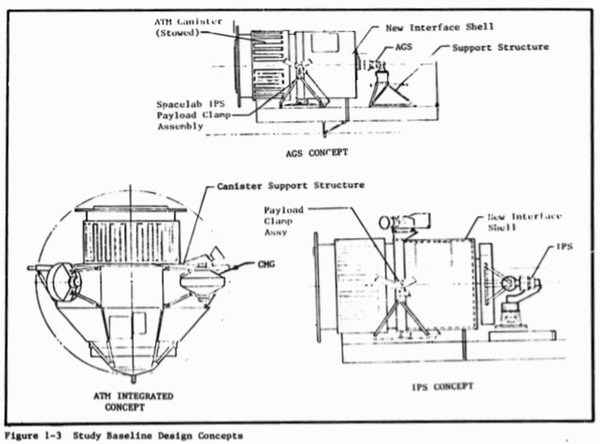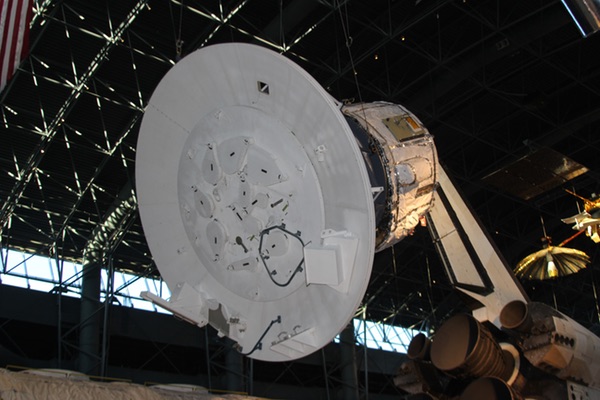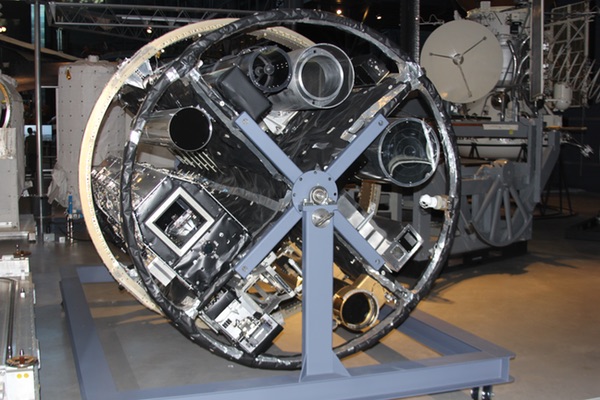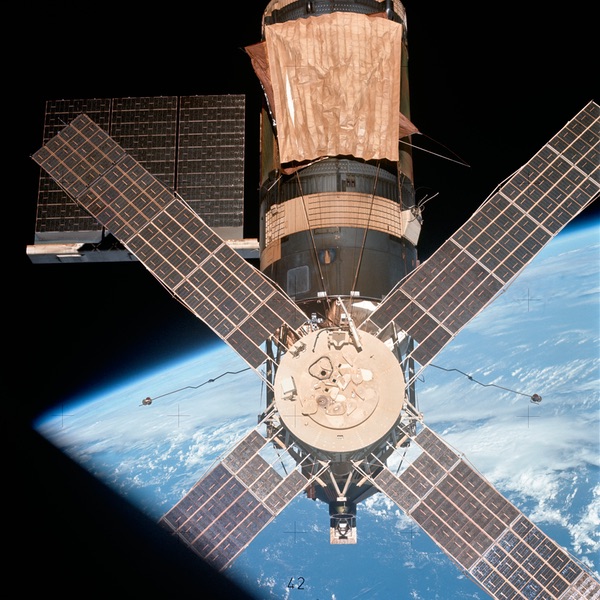From Skylab to Shuttle to the Smithsonianby Dwayne Day
|
| From February to December 1974, NASA initiated a number of studies of adapting the Apollo Telescope Mount to the Spacelab that was planned for operating in the shuttle payload bay. |
The transition from the Apollo era to the space shuttle was also messy and inefficient. NASA scrapped enough equipment to fly at least one more lunar landing and several low Earth orbit missions because Apollo’s goals were met and the agency needed to shift money to shuttle development. Of all the equipment NASA scrapped at the end of Apollo, perhaps the most tragic in terms of potential was the second Skylab workshop. Originally built as a backup, it was a complete space station in its own right. Had NASA possessed both the money and the goals, that Skylab could have flown and conducted valuable scientific research. The workshop was turned over to the Smithsonian Institution and much of it has occupied one of the main galleries in the National Air and Space Museum since 1976. But there was a brief proposal to fly some of that workshop’s hardware on a space shuttle mission in the 1980s. That plan never progressed, and today the hardware is on display at the Smithsonian’s Steven F. Udvar-Hazy Center.
Skylab was a big space station, and it was packed with experiments. Mounted perpendicular to the main structure was the Apollo Telescope Mount (ATM), which sprouted four extendable solar panels around a white cylindrical canister. That canister had multiple hatches on its top, and each could open to provide a viewing aperture for an instrument mounted below. The eight instruments were focused upon the Sun, and in 1973 when Skylab flew they were the most comprehensive suite of solar instruments ever flown in space. The instruments were all developed by individual principal investigators (PIs). NASA retained the ATM and its internal armature for mounting the instruments even while much of the rest of the Skylab workshop was put on display at the Smithsonian in 1976.
From February to December 1974, NASA initiated a number of studies of adapting the Apollo Telescope Mount to the Spacelab that was planned for operating in the shuttle payload bay. These included a “Spacelab ATM Feasibility Study” and a “Multiple Telescope Mount” study. The studies apparently primarily addressed using existing ATM hardware and instruments in the shuttle bay as well as adapting the ATM canister to carry new instruments. But the proposal was rejected at that time, and the ATM instruments were returned to the PIs who developed them, some of whom put them to use observing the Sun from the ground.
A little over six years later, in March 1981, Martin Marietta produced a report titled “Feasibility Study of the Solar Scientific Instruments for Spacelab/Orbiter.” The study addressed the issues associated with mounting an entirely new set of solar instruments inside the ATM hardware and carrying that in the shuttle payload bay. The study evaluated everything from thermal control, electrical power, attitude and pointing, to cost estimates. The study evaluated a strawman instrument payload, presumably based upon the kinds of instruments that the scientific community then wanted to fly.
 Best-quality image from a report showing possible methods of mounting the ATM canister inside the shuttle bay. It could be mounted either looking straight out of the bay, or on a gimbal device. The canister was attractive for shuttle use because it had its own cooling system and software, and was flight proven on Skylab. (credit: NASA) |
The ATM canister had a complete self-contained thermal control system that could maintain close thermal tolerance for the payload. Because the thermal control system was self-contained, there was no need to run fluid lines across the gimbals that would point the canister toward its targets, simplifying the design. The main attraction of the ATM hardware was that it already existed, and it was flight-proven by Skylab. Engineers knew that it was reliable, safe, and the software worked.
| The Martin Marietta report concluded that utilizing the backup ATM hardware for shuttle and Spacelab flights was both feasible and economical. |
Martin Marietta’s engineers looked at three baseline concepts. The first was called “ATM Integrated” and would have used the most backup hardware and software. This would still require a separate structure to mount the equipment in the payload bay with the canister pointing up, out of the bay, within a cradle. The entire space shuttle orbiter would then point the instrument canister towards its target. Although the study report is not entirely clear on this point, it appears that the intention was for the instrument to command the orbiter towards the target.
The two other concepts were known as IPS, for Instrument Pointing System; and AGS, for Advanced Gimbal System. They utilized only the canister and its associated equipment. The canister would have been mounted to the attachment rings of a pointing system—the IPS and AGS specifically referred to different types of gimbal mounts for pointing the equipment. The canister would be mounted horizontally inside the payload bay, and then gimbal upwards to point out of the bay in orbit. The IPS gimbaling system proposed for the ATM canister eventually flew on three shuttle missions (without the canister): Spacelab 2/STS-51-F in 1985, Astro-1/STS-35 in 1990, and Astro-2/STS-67 in 1995. The Spacelab 2 mission flew the Infrared Telescope, which was helium-cooled and had an aperture of 15.2 centimeters. The IRT, as it was known, was a demonstration lobbied for by astronomers to test the shuttle payload environment for infrared astronomy. The shuttle proved unsuitable, which led to a decision by astronomers that future infrared telescopes should be free-flyers, not in the shuttle bay.
Martin Marietta engineers concluded that the strawman instrument payload would not fit inside the ATM canister envelope, and it would have to be extensively modified to carry the instruments. But the engineers also determined that the equipment had substantial value if instruments could be developed that would fit within the canister. The ATM equipment could provide thermal control, pointing, and stability to a suite of instruments. The Martin Marietta report noted that a number of instruments were already under development for Spacelab and shuttle, and it was possible that some of them could fit into the ATM canister.
The Martin Marietta report concluded that utilizing the backup ATM hardware for shuttle and Spacelab flights was both feasible and economical. It recommended that the hardware be used unchanged or with only slight modifications for maximum cost effectiveness. This meant selecting scientific payloads that fit the physical and performance capabilities of the ATM hardware.
| One of the obvious drawbacks of the ATM was that it was big, and filling it and carrying instruments that fit it may have been challenging from a planning and scheduling standpoint. |
The report finished by recommending several additional tasks. These included determining the status of the remaining hardware and software items, including their location. Another task was identifying hardware, such as rubber gaskets and other materials, that had reached its life limit and would have to be replaced, as well as any additional testing or problem fixing required. Another task was structural and mechanical analysis to determine the design requirements for modifying the hardware. Finally, the report recommended conducting an attitude and pointing control analysis to verify the ATM’s capability to control the shuttle, as well as the fine pointing required by the experiments.
 The backup ATM now hanging at the Udvar-Hazy Center. (credit: D. Day) |
The ATM hardware never flew on the space shuttle. NASA flew Spacelab hardware on more than 20 shuttle flights, but not all of the flights were dedicated Spacelab missions and often the hardware flew with other equipment or satellites in the shuttle bay. One of the obvious drawbacks of the ATM was that it was big, and filling it and carrying instruments that fit it may have been challenging from a planning and scheduling standpoint. Sometimes Spacelab missions crammed a lot of different experiments into the payload bay.
According to Smithsonian curator David DeVorkin, the ATM spar and canister assembly were transferred from NASA to the National Air and Space Museum around 1982—after NASA officials decided not to fly the equipment on the shuttle. The canister and sunshield were placed on display in the “Stars” gallery in 1983, and remained on display there until 1997, although the spar was in storage during this time. After 1997 they were all put into storage. Meanwhile, DeVorkin collected other ATM telescopes and finally, in 2015, was able to reconstruct the ATM spar assembly of instruments, with the assistance of volunteer engineer Scott Willy. With staffer Anne McCombs’ persistence, the ATM canister, sunscreen, and the instruments went on display at the National Air and Space Museum’s Steven F. Udvar-Hazy Center in early 2017.
 The backup ATM armature with many of its instruments installed. (credit: D. Day) |
The ATM canister now hangs from the Udvar-Hazy museum’s ceiling, and the armature with the instruments is on display on the floor nearby. Recently the museum also acquired the InfraRed Telescope that flew on the shuttle in 1995. The vast majority of museum visitors will probably not comprehend what most of this this hardware is, but coincidentally, it now resides only a short distance from other shuttle-era Spacelab hardware, all sitting behind the space shuttle Discovery, which could have carried it into orbit if NASA officials had made different decisions back in the early years of the shuttle program.
